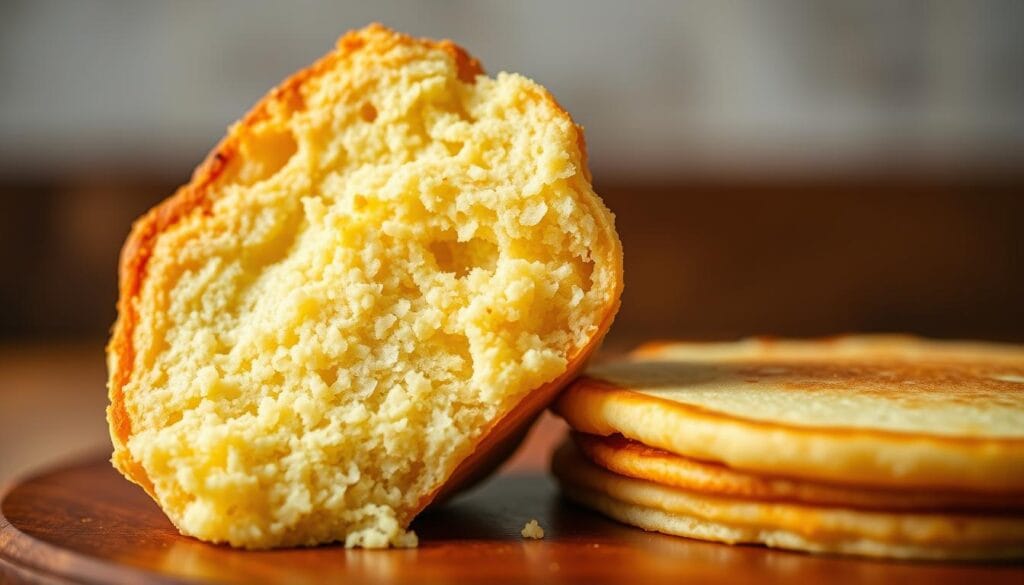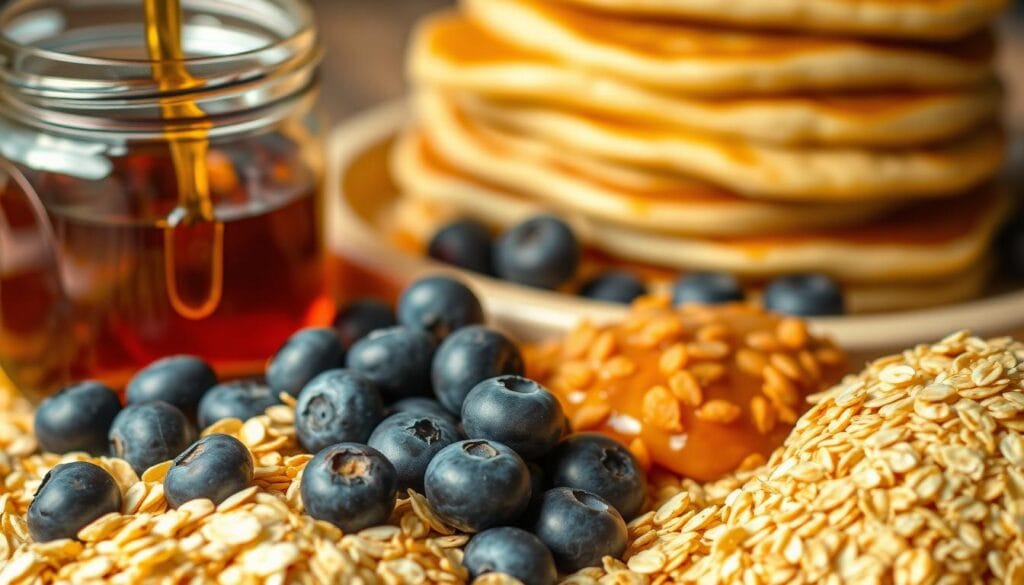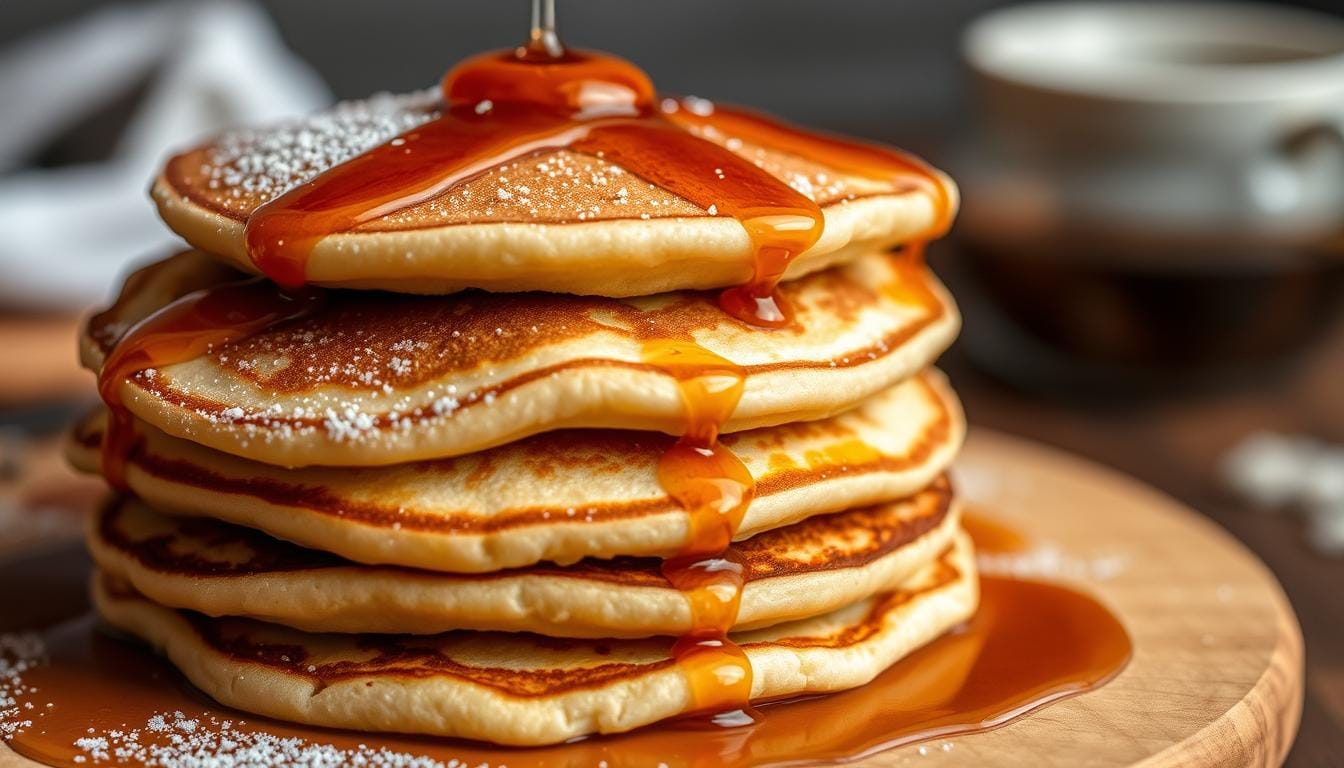What makes the perfect flapjacks or pancakes? Is it the ingredients, the cooking technique, or the secrets to crafting delicious pancakes that are not fluffy? You might be surprised to learn that using barista milk can make pancakes taste better. They become crispy on the outside and tender on the inside. A delicious pancake has about 240 calories and 33 grams of carbs, making it a great breakfast choice.
In this article, you’ll learn how to make delicious pancakes. We’ll cover various ingredients, cooking techniques, and tips. You’ll discover how to create the perfect flapjacks.
Exploring flapjacks and pancakes, you’ll see the value of fresh ingredients. This includes seasonal fruits and vegetables. You’ll also learn about different cooking methods, like baking in the oven or using a cast-iron skillet. With 30 unique pancake recipes to try, you can experiment with flavors and textures. From sweet to savory, and gluten-free to gluten-filled, there’s something for everyone. So, what are the secrets to crafting delicious pancakes that are not fluffy? Let’s dive in and find out.
Table of Contents
Understanding the Flapjack Difference
Exploring flapjacks reveals a clear flapjack difference in ingredients, texture, and cultural importance. The term “flapjack” can mean different flat cakes or pancakes, based on where you are. In the UK, flapjacks are dense and chewy, made with oats, butter, brown sugar, and golden syrup. In contrast, American pancakes are lighter and fluffier, with a batter of flour, eggs, milk, and leavening agents.
The cultural variations of flapjacks are fascinating. In North America and Canada, “flapjacks” and “pancakes” are often used the same way. But in the UK, they are different foods. British flapjacks are a snack or energy boost, eaten in the afternoon. American pancakes are mainly for breakfast. The unique texture and ingredients of flapjacks make them stand out from other pancakes.
Some examples of cultural variations of flapjacks include:
- British flapjacks: made from rolled oats, butter, brown sugar, and golden syrup
- Australian flapjacks: smaller and thinner compared to UK pancakes
- American pancakes: made with a batter that includes flour, eggs, milk, and a leavening agent

In conclusion, the flapjack difference comes from various cultural variations and unique traits. Understanding these differences lets you appreciate flapjacks’ rich history and cultural value. You can also try new recipes to make your own unique flapjack creations.
Essential Ingredients for Perfect Flapjacks
To make perfect flapjacks, you need the right ingredients. You’ll need rolled oats, brown sugar or coconut sugar, coconut oil or butter, and golden syrup or honey. These ingredients will make your flapjacks light, fluffy, and full of flavor.
For the flours, all-purpose flour is a good choice. It makes the texture light and fluffy. You can also try whole wheat or oat flour for a different taste and texture.
Here are some tips for choosing the right ingredients:
- Use high-quality ingredients for the best flavor and texture.
- Choose brown sugar or coconut sugar for a rich flavor in your flapjacks.
- Add a touch of golden syrup or honey for a sweet and sticky taste.

By following these tips and using the right ingredients, you can make delicious flapjacks. Don’t be afraid to try different ingredients and flavors to make a unique treat.
The Science of Flapjack Batter
Creating the perfect flapjacks starts with knowing the science of the batter. The right mix of ingredients and techniques is key. Too much mixing can make pancakes tough, while too little can make the batter too thin. It’s important to balance mixing and use the right ingredients like flour, sugar, and eggs.
To get a smooth batter, use the right mixing methods. Mix ingredients in the correct order and just until they blend. This avoids developing gluten in the flour, which can make the flapjacks chewy. It also prevents the batter from being too thin and lacking structure.
When mixing, consider the sugar to flour ratio, liquid amounts, and leavening agents. Too much sugar can make the batter too sweet and dense. Too little liquid can make it too thick and dry. Experimenting with different ratios and ingredients helps find the perfect mix for your flapjacks.
- Choose the right flour, like all-purpose or bread flour, for the best results.
- Avoid overmixing to prevent gluten development and a chewy texture.
- Use the right amount of liquid ingredients, such as milk or eggs, for the perfect consistency.
By following these tips and understanding the science of flapjack batter, you can make delicious and fluffy flapjacks for any occasion.
Cooking Methods: Griddle vs. Skillet
Choosing how to cook flapjacks can really change the taste. You can pick between a griddle and a skillet. Each has its own perks. The best method can make your flapjacks perfect and tasty.
A griddle cooks evenly and makes the outside crispy. Skillets, on the other hand, are versatile. They work well for many cooking styles. Here are some benefits of using a griddle or skillet:
Benefits of Griddle Cooking
- Even cooking: A griddle cooks everything evenly, so your flapjacks are always right.
- Crispy exterior: High heat from a griddle makes the outside of flapjacks crispy.
- Easy to use: Griddles are simple to use and don’t need much care.
Skillet Cooking Benefits
Skillets are great because they can do many things. You can fry, sauté, or bake with them. Some good things about using a skillet include:
- Versatility: Skillets are good for many cooking ways, perfect for flapjacks.
- Easy to clean: Skillets are easy to clean and don’t need much upkeep.
Both griddles and skillets have their advantages. Griddles are best for even heat, while skillets are good for versatility. Picking the right method can make your flapjacks delicious and full of flavor.
Flapjack Cooking Techniques
When cooking flapjacks, temperature control is key. The best temperature is between 325°F and 350°F. This range ensures even cooking and prevents them from getting too dark or crispy.
To get the cooking time right, watch the flapjacks closely. The time needed can change based on their size and thickness.
Here are some tips for the optimal cooking time:
- Preheat the oven to the correct temperature before cooking the flapjacks.
- Use a timer to ensure the flapjacks are cooked for the correct amount of time.
- Check the flapjacks regularly as they cook to prevent overcooking.
Mastering flapjack cooking techniques means controlling temperature and cooking time. Stay focused and adjust as needed for the perfect texture and flavor.
Flavor Enhancements for Flapjacks
Flapjacks offer endless flavor possibilities. You can mix extracts and spices into the batter for a unique taste. Vanilla or almond extract can add a delicious twist. Spices like cinnamon, nutmeg, and ginger bring warmth and comfort.
Fruits and nuts can also enhance your flapjacks. Blueberries, cranberries, or raisins add natural sweetness. Walnuts, almonds, or pecans add crunch and a nutty flavor. Some favorite enhancements include:
- Adding fruit, such as blueberries or bananas, to the batter for added flavor and moisture
- Incorporating nuts, like walnuts or pecans, for a crunchy texture and nutty flavor
- Using spices, such as cinnamon or nutmeg, to add warmth and depth to the flavor
- Adding a hint of extract, like vanilla or almond, to create a unique flavor combination
Exploring different flavor enhancements can lead to amazing flapjacks. Whether you like sweet or savory, there’s something for everyone. So, don’t hesitate to try new combinations and find your favorite.
Common Mistakes When Making Flapjacks
Making flapjacks can be tricky. One big mistake is not checking the batter’s consistency. This can make your flapjacks too thick or too thin. Another error is not watching the cooking time, like when bubbles form on the pancake. This can cause your flapjacks to be undercooked or overcooked.
To avoid these mistakes, focus on the batter’s consistency and watch for cooking signs. Wait for bubbles to form and pop on the pancake before flipping it. Also, using a nonstick pan or griddle helps prevent sticking and makes flipping easier.
Other mistakes to watch out for include:
- Overmixing the batter, which can make flapjacks tough and chewy
- Not letting the batter rest, which can make the flour absorb the liquid better and result in a tender flapjack
- Choosing the wrong type of flour, which can change the texture and taste of the flapjacks
By avoiding these mistakes and paying attention to batter consistency and cooking time, you can make delicious flapjacks.
Remember, making flapjacks takes practice. Don’t get discouraged if your first batch doesn’t turn out right. Keep trying, and you’ll soon be making perfect flapjacks with the right batter consistency and cooking time.
Creative Toppings for Flapjacks
Flapjacks can be made special with the right toppings. You can pick from many creative toppings to add unique flavors and textures. Options range from traditional topping ideas like syrup and butter to innovative alternatives like fresh fruits and nuts.
Popular traditional topping ideas include maple syrup, honey, and powdered sugar. But you can also try innovative alternatives like roasted berries, cannoli filling, or savory stuffed pancakes. The goal is to mix flavors and textures that make your flapjacks stand out.
- Fresh or frozen fruits, such as berries or bananas
- Nuts, like walnuts or pecans
- Spreads, such as peanut butter or Nutella
- Cookie crumbs or crushed cookies
Remember, the toppings can turn your flapjacks into a tasty and fulfilling meal. So, don’t hesitate to explore new innovative alternatives to traditional toppings.
Flapjack Variations to Try at Home
Exploring flapjacks opens up a world of flavors and textures. You can find everything from sweet treats to savory delights. With flapjack variations, you can make unique and tasty treats that will wow your loved ones.
Flapjack making is all about trying new things. You can add savory recipes like herbs and spices for a savory snack. Or, choose gluten-free options for those with dietary needs.
Popular flapjack variations include nuts, seeds, or dried fruits. You can also use different sugars like honey or maple syrup. For a twist, add cheese, bacon, or eggs for a savory recipes touch.
For gluten-free options, try rice flour, almond flour, or coconut flour. Mixing different milks or yogurts can also make your flapjacks creamy and delicious.
To start making your own flapjack variations, experiment with ingredients and flavors. Look online or in cookbooks for ideas, or let your creativity shine. Soon, you’ll be whipping up your own savory recipes and gluten-free options.
Serving and Storing Flapjacks
Once you’ve mastered the art of crafting delicious flapjacks, it’s time to explore the best ways to serve and store them. Flapjacks are a versatile breakfast treat that can be enjoyed in a variety of ways. Top them with your favorite fruits, nuts, or a drizzle of maple syrup for a classic taste.
For a creative twist, try adding a scoop of ice cream or a sprinkle of powdered sugar. When it comes to storing leftover flapjacks, the key is to keep them fresh and easy to reheat. Wrap them individually or place them in an airtight container, then pop them in the freezer for up to a month.
To enjoy your flapjacks later, simply reheat them in the oven or toaster until warm and crisp. With these serving and storage tips, you can savor the perfect flapjack experience whenever the craving strikes.
FAQ
Why are my flapjacks not fluffy?
Flapjacks can lack fluffiness if the batter is over-mixed, too thick, or if the baking powder or baking soda isn’t fresh. To ensure fluffiness, use the right amount of leavening agent, avoid over-mixing the batter, and let it rest before cooking.
What makes pancakes rise and fluffy?
The key to fluffy pancakes is the use of baking powder or baking soda, which creates air bubbles during cooking, making them rise. A thick batter and proper heat also help achieve the ideal fluffiness.
Why is my flapjack too soft?
If your flapjack is too soft, it may be due to an excess of liquid or undercooking. Make sure you’re using the right ratio of dry to wet ingredients and cooking at the proper temperature to firm up the texture.
Why do my homemade flapjacks fall apart?
Homemade flapjacks may fall apart if there isn’t enough binding agent like eggs or flour, or if the batter is too runny. Be sure to adjust the consistency of the batter and cook them long enough for a solid base.

